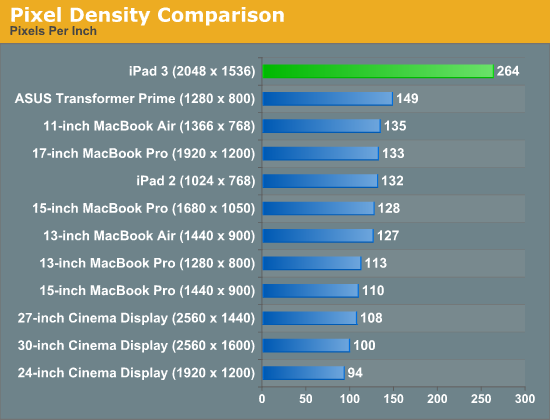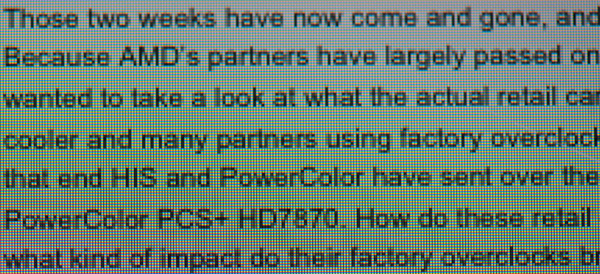The new iPad: Retina Display Analysis
by Anand Lal Shimpi on March 19, 2012 5:49 PM ESTWe're hard at work on our review on the new iPad but with a fair bit of display analysis under our belts I thought a quick post might be in order. One of the major features of the new iPad is its 2048 x 1536 Retina Display. Apple kept the dimensions of the display the same as the previous two iPad models, but doubled the horizontal and vertical resolution resulting in a 4x increase in pixels. As display size remained unchanged, pixel density went through the roof:

Although the iPad 2 has a fairly high pixel density compared to most of Apple's Mac/display lineup, you're more likely to hold a tablet closer to your eyes which made the low resolution/pixel density problematic. The new iPad addresses this issue as you can see from the chart above. I can't focus closely enough to the panel to actually make out pixels on the new iPad, much less at a normal viewing distance. With the aid of a macro lens we can definitely identify individual pixels. The improvement over the iPad 2 display is striking:
To the left we have the original 1024 x 768 panel, and to the right we have the new Retina Display. At this distance you can still identify individual pixels, an ability that quickly vanishes at normal viewing distances. The Music app icon is an even better example of what you gain from the newer display as it has more high contrast edges that appear more aliased on the 1024 x 768 panel:
The old iPad's 1024 x 768 resolution was fairly bothersome when it came to reading text on web pages or books. Most Android tablets standardizing on 1280 x 800 offered an advantage in that respect, albeit not delivering significantly higher pixel density. The new iPad completely resolves this issue. Hover over the links below to see roughly the same paragraph of text from our retail Radeon HD 7870 review on the iPad 2, new iPad and ASUS Transformer Prime:

| Apple iPad 2 | Apple iPad (3rd gen) | ASUS TF Prime |
| original | original | original |
While it's still obvious that you're looking at a screen and not an e-ink display, the pixels perform a good disappearing act on the new iPad.












172 Comments
View All Comments
gorash - Tuesday, March 20, 2012 - link
I mean to say "it helps to have a faster CPU".tmuller2 - Tuesday, March 20, 2012 - link
You notice how you tend to justify everything on hardware specs? It may have a slower CPU, yet performance and actual usage is well those devices with faster chips. If having a faster CPU is so important, then why hasn't Apple used them? That would be an easy fix right? Why would Apple want to handicap itself by using such low specs? The answer is because it doesn't need to. Clock speeds are clock speeds and the only thing that matters is the user experience. In my experience, Apple devices by far have the best experience and stability. So what ever numbers listed in tech specifications, are just that. May look great on paper.gorash - Wednesday, March 21, 2012 - link
Are you saying that for example, web sites don't load faster with a faster CPU? With a slow CPU, it's impossible for web pages to load fast no matter how good the OS is.Mystermask - Thursday, March 22, 2012 - link
"Are you saying that for example, web sites don't load faster with a faster CPU?"Are you saying that you can compare the user experienced speed of the devices with different OSs / apps by comparing the (paper) CPU specs?
Sorry, how stupid is that?!
Those tech specs / cheapest parts prices fetishists are really funny. Unable to learn from a long history of 'paper spec marketing', they think they are cleverer than the rest of the world but are in fact easier to influence than people who are able to choose by defining their needs and comparing those needs to real world experience with a set of given devices.
doobydoo - Wednesday, March 21, 2012 - link
Ever notice that I'm correcting you all the time, and that the corrections happen to be pro-Apple because you're ridiculous Android bias leads you to make ridiculous claims?Both CPU and GPU matter. Overall, taking into account both, the iPad has better performance. This is backed up by all the impartial reviews which note how smooth and fast it feels, in comparison to Android tablets. It also has by far the highest resolution and largest App store.
gorash - Wednesday, March 21, 2012 - link
ICS is already smooth because it supports hardware acceleration, which Android didn't used to have. Most of the reviews are based on Honeycomb. "iOS is smooth blah blah blah" - that's just because iOS has hardware acceleration, just like WP7, which people also say that it is very smooth.doobydoo - Thursday, March 22, 2012 - link
The same ICS which the Galaxy Tab doesn't support yet?Mystermask - Wednesday, March 21, 2012 - link
Hm. So you need to buy several different tablets to compete with an iPad? LOL. Sounds 'overpriced' to me(Those points are stupid: you will always find one other product that has a better implementation of feature X (price, size, smell, you name it), while laking in other areas. But at the end, you want ONE device. So such comparisons are moot.)
lukarak - Tuesday, March 20, 2012 - link
Why not go deeper? Samsung also buys components from various manufacturers, and puts it together. They don't make the backlight, the frame, the glass cover. You can go so deep to end up with only mining companies on your list, because everything we use comes from the earth (be it metals, oil (for plastic), and so on). Whatever the case, samsung didn't put the product to market, Apple did. Samsung's just going to see what Apple is successful at and copy it. Just like everybody else.medi01 - Wednesday, March 21, 2012 - link
Which of the mentioned stuff is high tech, that you can't get from other suppliers. pretty please? Are you seriously comparing screens and glass covers?